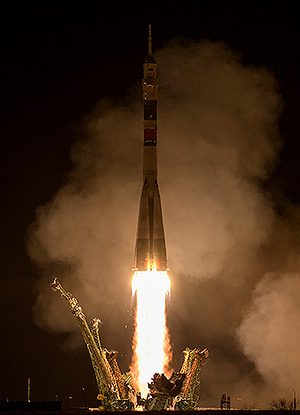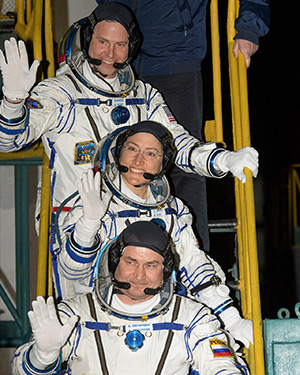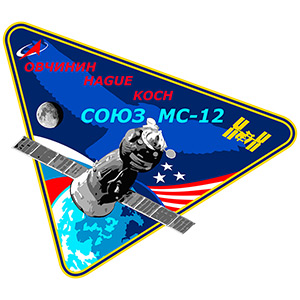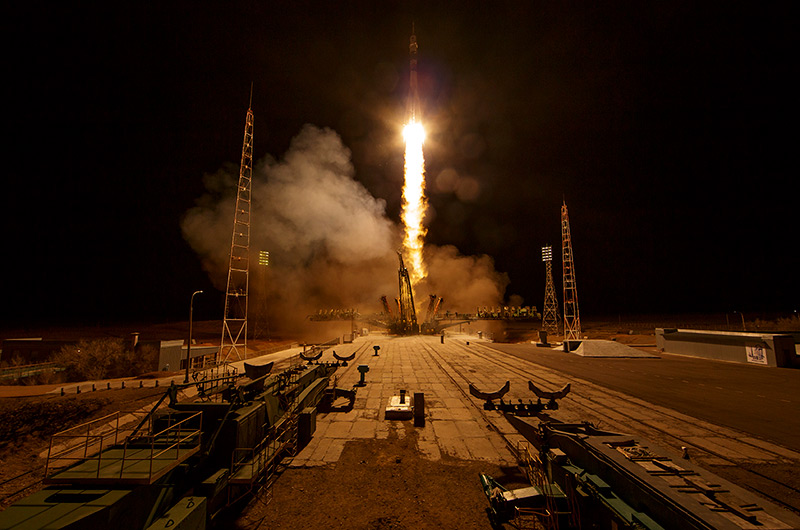 advertisements advertisements
|

|
Crew of Soyuz launch abort lifts off to space station on second try
March 14, 2019 — Nick Hague's second launch to space went much better than his first.
The NASA astronaut joined his Soyuz MS-10 crewmate, cosmonaut Aleksey Ovchinin of Roscosmos, for a second attempt at reaching the International Space Station, five months after an in-flight abort cut their first launch together short.
This time, Hague, Ovchinin and NASA astronaut Christina Koch safely made it into Earth orbit on Russia's Soyuz MS-12 spacecraft. The three lifted off atop a Soyuz FG rocket from the Baikonur Cosmodrome in Kazakhstan at 3:14 p.m. EDT (1914 GMT or 12:14 a.m. on March 15 Kazakh time) to begin a six-hour rendezvous with the space station.
Unlike on Oct. 11, 2018, when a booster separation problem with the Soyuz rocket's first stage triggered the Soyuz MS-10 spacecraft to make an emergency landing two minutes into the flight, the Soyuz MS-12 launch proceeded smoothly and to plan. Hague, Ovchinin and Koch are scheduled to dock to the station's Rassvet module at 9:07 p.m. EDT (0107 GMT), marking the start of the orbiting laboratory's 59th crewed expedition. Update: Docking occurred at 9:01 p.m. EDT (0101 GMT) while the two vehicles were 255 miles (410 km) over the Pacific.
"The abort, for me, definitely underscores that what we do is risky, but we knew that going into this. So you then think about the risks that are associated with spaceflight and why we do those things," said Hague at a pre-launch press conference on Wednesday. "The science we are going to perform on board the station and the benefit that it is going to have not only to help us go deeper into space and explore the universe, but also help those on the ground and just better understand the world around us and ourselves. That is an important mission."
Once at the space station, Hague, Ovchinin and Koch will join their Expedition 59 crew mates, Oleg Kononenko of Roscosmos, NASA astronaut Anne McClain and David Saint-Jacques of the Canadian Space Agency, who have been aboard the orbital complex since December. Together, the six crew members will continue work on hundreds of experiments in biology, biotechnology, physical science and Earth science.
Hague and Koch will also join McClain and Saint-Jacques on a series of three spacewalks to upgrade the station's power system and install hardware for a future science platform. The second of these extravehicular activities (EVA), to be conducted by McClain and Koch, will be the first-ever spacewalk by two women.
"I am greatly looking forward to the potential opportunity to do a spacewalk. Not only is it an exceptional professional opportunity, but moreover it is an opportunity to contribute to upgrading the station so that it can continue to work like a well-oiled machine for many years into the future and can continue to be a platform and a laboratory for great science," said Koch. "If I am fortunate enough to do the spacewalk with Anne McClain, it will be a great honor for me to potentially inspire future space explorers, as well as pay homage to those who paved the path for us to be where we are today."
Koch, 40, is on her first space mission. Selected as an astronaut in 2013, Koch previously worked as an electrical engineer at the Goddard Space Flight Center's Laboratory for High Energy Astrophysics, contributing to scientific instruments on several cosmology missions.
Hague, 43, is making his second spaceflight after reaching the fringes of space aboard the Soyuz MS-10 abort. Also a member of NASA's 2013 astronaut class (nicknamed the "8 Balls"), he is a colonel in the U.S. Air Force and has a masters degree in aeronautical and astronautical engineering from the Massachusetts Institute of Technology (MIT).
Ovchinin, 47, is on his third mission to the space station. In 2016, he logged 172 days as commander of Soyuz TMA-20M and an Expedition 47/48 flight engineer.
Ovchinin will become the commander of the Expedition 60 crew when Kononenko, McClain and Saint-Jacques leave on board Soyuz MS-11 for Earth in June. Soyuz MS-12 is slated to return in October, but who will be aboard the spacecraft is still to be determined.
One of the three Soyuz MS-12 crew members is expected to remain on the station after the other two leave to free up a seat home for a United Arab Emirates (UAE) astronaut who is launching on a short-stay taxi flight to the complex in September.
"This question is currently being decided," said Ovchinin on Wednesday. "There are some options available, but after our launch, the issue will be resolved and we will have the final information about who of us is going to stay there for longer than expected."
Update: Bill Gerstenmaier, NASA's Associate Administrator for Human Exploration and Operations, speaking at a post-launch press conference confirmed that Koch will "stay longer than the 180 days" on the station. "We're working with Roscosmos to finalize the flight plan for this year, and in that flight plan our crews will end up staying a bit longer, the U.S. crews will, and that will allow the UAE expedition in the fall."
Soyuz MS-12 is Russia's 58th Soyuz spacecraft to launch toward the International Space Station since 2000 and 141st to fly since the first Soyuz mission in 1967. |
|

Soyuz MS-12 launches for the International Space Station from the Baikonur Cosmodrome, March 14, 2019. (NASA/Bill Ingalls)

Soyuz MS-12 crew members Aleksey Ovchinin, Nick Hague and Christina Koch wave from the base of their Soyuz FG rocket prior to boarding the vehicle for launch, March 14, 2019. (NASA/Bill Ingalls)

Soyuz MS-12 crew mission patch. (Roscosmos/spacepatches.nl) |

The Soyuz MS-12 spacecraft is launched with Expedition 59 crewmembers Aleksey Ovchinin of Roscosmos and Nick Hague and Christina Koch of NASA, Thursday, March 14, 2019 (March 15 Kazakh time) at the Baikonur Cosmodrome in Kazakhstan. (NASA/Bill Ingalls) |
|

© collectSPACE. All rights reserved.
|
|

|

|
